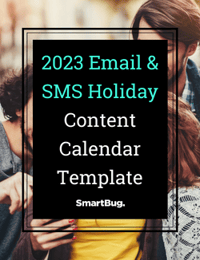
By Shelby Bell
Segmentation for your email and SMS campaigns could be viewed as complicated or daunting, but it’s incredibly important. Segmentation is the process of dividing your email and SMS lists into smaller groups based on behavior, engagement, and common characteristics.
Think of it like dividing your wardrobe into sections: shirts in the closet, pants in your dresser drawers, and a section for shoes. With this kind of organization, it’s easy to find what you need without having to sift through a big pile of everything. Plus, you find exactly what you need in the spot where it’s supposed to be.
A similar mindset can be applied to your email and SMS lists. When you segment all of your subscribers into smaller groups, you can personalize messages to their behavior and specific needs or interests. When this happens, it leads to more engagement and ultimately increases your ROI.
Why Does Email Segmentation Matter?
According to SmartBug Media® partner Klaviyo, when you use email segmentation, it feels more like a one-to-one communication as opposed to batch-and-blast sending. We all want to feel special and catered to, so when your audience feels like you’re speaking directly to them with personalized content, they’re more likely to engage.
This personalized segmentation can also create opportunities for faster conversion because the products they are interacting and engaging with are being delivered directly to them. Engaged subscribers with targeted messaging are more likely to make purchases, resulting in increased ROI for your brand. In addition to loyalty, you build trust with your audience.
Reflect on your own past experience as a consumer. When you received messages from brands you’ve subscribed to with products that you viewed or more information from products you considered buying, not only did you make a purchase, you likely continued to make more depending on the brand. You remembered the personalized experience with a brand that puts effort into tailored messages.
Common Email Segmentation Methods
How can you segment your audience? Honestly, the possibilities are endless! However, segmenting strategies based on demographics, purchase history, and engagement levels are the most common.
Demographic Data
Segmenting based on demographics can reference age, gender, location, and more. For instance, segmenting based on location could be beneficial in situations where brick-and-mortar locations are running promotions and hosting events, or when your brand has updates pertinent to purchasers in a specific geographic location.
Purchase History
Segmenting based on purchase history separates users based on their previous buying behaviors. For example, if you’re a retailer selling supplements, you can segment users based on the supplements a subscriber has purchased in the past. You could send them targeted messages promoting new arrivals, specific supplement sales, items that are similar to past purchases, or back-in-stock notifications. This makes your messaging more relevant to each subscriber, and it increases the chance of them making additional purchases.
Engagement Levels
Segmenting based on engagement levels divides your audience based on their past behavior when it comes to interacting with your SMS messages or emails. This allows you to target messages to each level of engagement.
For instance, you could segment your list into three (or more) groups: low-engaged, moderately engaged, or highly engaged subscribers. You could also break this down into time frames based on engagement: engaged in the last 30 days, last 60 days, last 90 days, or last 365 days for a larger group of people.
For highly engaged subscribers, you could send special offers, exclusive content, and rewards. Subscribers who aren’t as engaged could be motivated back into the highly engaged bucket with re-engagement campaigns or offers that invite them to open and interact with your messages again.
In a SmartBug case study, this kind of segmentation for email and SMS marketing helped California Olive Ranch see revenue totals jump up 94 percent in just nine months over the same period during the previous year. Putting segmentation into practice for more targeted messaging can really pay off!
Testing and Optimizing Email Segmentation Strategies
Once you start building segments, it’s important to test and optimize the strategy behind them. Two ways that you can do this are with A/B testing and analyzing your data and metrics.
A/B Testing
A/B testing is essentially creating a science experiment for your email and SMS marketing. It is a strategy that involves creating two versions of your message and testing them against each other to see which performs better with your audience.
You can test subject lines, images used, sender names, and so on. It’s important to test one feature at a time in order to properly identify the “winner.” Applying that experiment to your messages is how you can figure out what works best for your audience and your brand as a whole. You can even A/B test one variation of a message sent to one audience segment, with another variation of the message sent to an alternate segment to see which performs better.
A surprising 39 percent of brands aren’t testing their segmented emails—which means they’re missing out on valuable data! Doing this can ensure that your messages are optimized and your subscribers are engaging with what they're receiving, leading to more conversions.
When increasing ROI through segmentation is your goal, don’t be afraid to get experimental with A/B testing. Who knows? You might just discover the secret sauce that takes your campaigns to the next level with your subscribers!
Analyzing Data and Metrics
Analyzing segment data and metrics is like a treasure hunt to discover trends and specific insights that boost your ROI with segmentation. While on this treasure hunt, you’ll find gold in what your users are responding to and then use that data to maximize engagement and conversion rates! This data can also identify patterns that help your future campaign strategies.
Analyzing your data and metrics is a crucial part of any effective email and SMS segmentation strategy, so it’s important to review on a regular basis to analyze what’s working best for your brand.
Audience Segmentation: The Key to Email Marketing Success
Segmentation of your list may seem daunting at first, but it’s a crucial part of working toward higher engagement rates, higher conversion rates, and increased ROI. Once you start building those segments, keep testing and analyzing the data you collect from the behavior of users within each segment. It truly allows you to personalize all your messaging to the behavior and specific interests and needs of your audience, and it makes users feel like they’re on a journey alongside you.
In our 2023 Email & SMS E-Commerce Content Calendar Template, you can create your own content calendar applying our four-peaks strategy while using segmentation to hone in on your key audiences for different email and SMS campaigns. By segmenting campaigns around specific holidays, you can increase ROI and promote customer engagement. Why not start segmenting your audience today and watch your business grow?

About the author
Shelby Bell Shelby Bell is an E-Commerce Marketing Specialist at SmartBug Media with a passion for helping businesses thrive in the digital world. With a dedication to staying up-to-date with the latest trends and techniques, Shelby is a driving force behind the success of numerous clients, with the assistance of her peers. Shelby has an understanding of the power of targeted messaging to drive conversions and build brand loyalty. Shelby is behind the scenes to help organize comprehensive marketing strategies to help meet goals, and is committed to delivering measurable results and helping clients achieve their business goals. Read more articles by Shelby Bell.





















